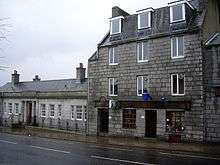The Soap Factory
The Soap Factory at 111 Gallowgate, Aberdeen, Scotland, was built for Ogston & Tennant, soap and candle manufacturers, in 1922. The building was designed to be the formal office and to stand detached from the main factory and warehouses, which opened onto Loch Street.[1] Ogston & Tennant ceased trading in the 1970s, and the building is now used as offices. It is a category C listed building.[2]

The building
The architect credited with the design of 111 Gallowgate is Alexander Mavor who designed the soap-works for Ogston & Tennant.[3] Alexander Mavor trained as a builder in London before moving to Scotland and joining William Henderson & Sons architectural practice. He became a partner there before leaving to start his own business.[4]
The building on the Gallowgate side has a low classical profile and is built from Kemnay granite. The main entrance has granite steps leading up to two Doric columns set either side of a recessed timbered door. The listing makes particular mention of the granite boundary wall topped with decorative metal railings.[2] To the rear is the basement which is built from brick, not granite, and housed Ogston & Tennant's industrial laboratories.
In 1941 the Loch Street side of the factory site was bombed.[5] At some point in the 1970s Ogston and Tennant ceased trading and the building was then used as a Waldorf school.[6] The interior of the building has been modernised to include serviced office and media space.
Brief history of Ogston & Tennant
Ogston & Tennant Ltd. was formed in 1898 from two companies joining A. Ogston & Sons and Charles Tennant and Co.[7] At the time of the merger Ogstons already owned both a factory and warehouses in Loch Street, Aberdeen. On 9 March 1910 the company won damages against the Glasgow Daily Record for defamation. This was in connection with another libel, by the Daily Mail against Lever Brothers. It totalled £9,000 and the news was reported around the world.[8]
On 28 June 1910 they suffered a great fire which engulfed and destroyed the factory. Reports mention machinery crashing through the floors. Damage totalled £80,000.[9][10] In 1911 the company agreed to an "association" with Lever Brothers and after the second world war, they became part of the company until they ceased trading in the 1970s.[11]
References
- "Aberdeen, Loch Street, Ogston And Tennant Factory Site". CANMORE. Royal Commission on the Ancient and Historical Monuments of Scotland. Retrieved 21 March 2012.
- Historic Environment Scotland. "111 Gallowgate Including Boundary Wall and Railings (Category C) (LB20316)". Retrieved 15 March 2019.
- "Alexander Mavor". Dictionary of Scottish Architects. www.scottisharchitects.org.uk. Retrieved 21 March 2012.
- "William Henderson & Son". Dictionary of Scottish Architects. www.scottisharchitects.org.uk. Retrieved 21 March 2012.
- Murray, Sam. "Memories from Eastleigh Nursing Home, Peterculter: Sam Murray". WW2 Peoples War. BBC / Aberdeen Libraries. Retrieved 21 March 2012.
- "Aberdeen, 111 Gallowgate And Railings". CANMORE. Royal Commission on the Ancient and Historical Monuments of Scotland. Retrieved 21 March 2012.
- "Ogston and Tennant". Grace's Guide British Industrial History. www.gracesguide.co.uk. Retrieved 21 March 2012.
- "Defamation". PapersPast. paperspast.natlib.govt.nz. Retrieved 21 March 2012.
- "A Conflagration". PapersPast. paperspast.natlib.govt.nz. Retrieved 21 March 2012.
- "GREAT FIRE IN GLASGOW". The Register. Adelaide: National Library of Australia. 29 June 1910. p. 8. Retrieved 22 March 2012.
- "Ogston and Tennant". British Industrial History. Graces Guide. Retrieved 21 March 2012.